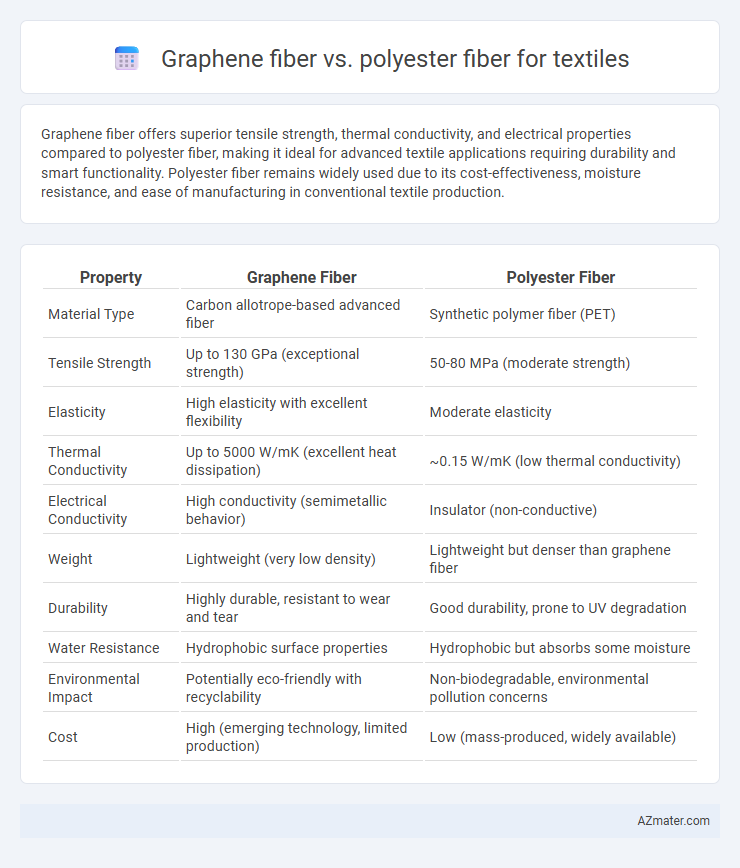Graphene fiber offers superior tensile strength, thermal conductivity, and electrical properties compared to polyester fiber, making it ideal for advanced textile applications requiring durability and smart functionality. Polyester fiber remains widely used due to its cost-effectiveness, moisture resistance, and ease of manufacturing in conventional textile production.
Table of Comparison
| Property | Graphene Fiber | Polyester Fiber |
|---|---|---|
| Material Type | Carbon allotrope-based advanced fiber | Synthetic polymer fiber (PET) |
| Tensile Strength | Up to 130 GPa (exceptional strength) | 50-80 MPa (moderate strength) |
| Elasticity | High elasticity with excellent flexibility | Moderate elasticity |
| Thermal Conductivity | Up to 5000 W/mK (excellent heat dissipation) | ~0.15 W/mK (low thermal conductivity) |
| Electrical Conductivity | High conductivity (semimetallic behavior) | Insulator (non-conductive) |
| Weight | Lightweight (very low density) | Lightweight but denser than graphene fiber |
| Durability | Highly durable, resistant to wear and tear | Good durability, prone to UV degradation |
| Water Resistance | Hydrophobic surface properties | Hydrophobic but absorbs some moisture |
| Environmental Impact | Potentially eco-friendly with recyclability | Non-biodegradable, environmental pollution concerns |
| Cost | High (emerging technology, limited production) | Low (mass-produced, widely available) |
Introduction to Graphene Fiber and Polyester Fiber
Graphene fiber, composed of single-layer carbon atoms arranged in a hexagonal lattice, offers exceptional strength, electrical conductivity, and flexibility, making it an innovative material for advanced textile applications. Polyester fiber, a synthetic polymer derived from petroleum, is widely known for its durability, wrinkle resistance, and moisture-wicking properties, dominating the textile industry due to cost-effectiveness and versatility. Comparing graphene fiber with polyester highlights significant advancements in tensile strength and conductivity, presenting opportunities for high-performance, smart textile development.
Composition and Structure Comparison
Graphene fiber is composed of a single layer of carbon atoms arranged in a hexagonal lattice, offering exceptional strength, electrical conductivity, and flexibility compared to polyester fiber, which is a synthetic polymer made from polyethylene terephthalate (PET) characterized by a long chain of ester groups. The atomic structure of graphene fiber grants superior tensile strength and thermal conductivity, while polyester fibers exhibit chemical stability, elasticity, and resistance to water and UV light due to their semi-crystalline polymer structure. These distinct compositions result in graphene fibers being lightweight and highly conductive, making them ideal for advanced textile applications requiring mechanical robustness and conductivity, whereas polyester fibers are favored for their durability, cost-effectiveness, and ease of processing in mainstream textile manufacturing.
Mechanical Strength and Durability
Graphene fiber exhibits superior mechanical strength compared to polyester fiber, with tensile strength reaching up to 130 GPa, vastly outperforming polyester's typical range of 30-50 MPa. The atomic structure of graphene provides exceptional durability, resistance to wear, and resilience under cyclic loading, whereas polyester fibers can degrade over time with UV exposure and mechanical fatigue. This makes graphene fiber an ideal choice for high-performance textile applications demanding long-lasting strength and structural integrity.
Thermal Conductivity and Insulation Properties
Graphene fiber exhibits superior thermal conductivity compared to polyester fiber, enabling faster heat dissipation and enhanced temperature regulation in textile applications. Its exceptional insulation properties also provide efficient thermal management by maintaining warmth in cold environments while preventing overheating. In contrast, polyester fiber has lower thermal conductivity and insulation capabilities, making graphene fiber a more advanced choice for high-performance thermal textiles.
Moisture Management and Breathability
Graphene fiber exhibits superior moisture management capabilities due to its excellent thermal conductivity and hydrophobic properties, allowing rapid sweat evaporation and keeping the skin dry. Polyester fiber, while offering durability and quick-drying features, tends to trap moisture, reducing breathability and causing discomfort during prolonged wear. Advanced textiles incorporating graphene fibers enhance breathability and moisture wicking, making them ideal for high-performance activewear and smart fabrics.
Flexibility and Comfort in Textiles
Graphene fiber offers superior flexibility compared to polyester fiber due to its molecular structure, allowing fabrics to stretch and conform more naturally to body movements. The enhanced breathability and thermal conductivity of graphene fiber contribute to greater comfort by efficiently regulating temperature and moisture in textiles. Polyester fiber, while durable and cost-effective, lacks the same level of softness and flexibility, often resulting in less comfortable and less adaptive clothing materials.
Environmental Impact and Sustainability
Graphene fiber offers superior environmental benefits compared to polyester fiber due to its biodegradability and lower carbon footprint during production. Polyester fiber, derived from petroleum, contributes significantly to microplastic pollution and consumes more energy and water throughout its lifecycle. The sustainability of graphene fiber is enhanced by its recyclability and potential to reduce reliance on fossil fuels, making it a more eco-friendly choice for textile manufacturing.
Cost and Production Scalability
Graphene fiber offers superior strength, conductivity, and flexibility compared to polyester fiber but comes with significantly higher production costs due to complex synthesis and raw material expenses. Polyester fiber benefits from well-established manufacturing processes with high scalability, enabling low-cost mass production suitable for large-volume textile markets. Cost-effective polyester production maintains its dominance, while graphene fiber scalability remains limited, restricting its use primarily to specialized applications despite promising performance advantages.
Potential Applications in the Textile Industry
Graphene fiber offers superior tensile strength, electrical conductivity, and thermal management compared to polyester fiber, enabling innovative applications in smart textiles and wearable electronics. The integration of graphene fiber enhances durability, flexibility, and anti-bacterial properties, making it ideal for high-performance sportswear and protective clothing. Polyester fiber remains widely used due to cost-effectiveness and moisture-wicking properties but lacks the advanced multifunctional capabilities critical for next-generation textile innovations.
Future Trends and Innovations in Textile Fibers
Graphene fiber demonstrates exceptional strength, conductivity, and flexibility, positioning it as a revolutionary material in the textile industry compared to traditional polyester fiber. Future trends emphasize the integration of graphene fibers to develop smart textiles with enhanced durability, thermal regulation, and wearable technology compatibility. Innovations focus on scalable production methods and eco-friendly manufacturing processes to replace polyester fibers, reducing environmental impact while improving textile performance.

Infographic: Graphene fiber vs Polyester fiber for Textile
 azmater.com
azmater.com